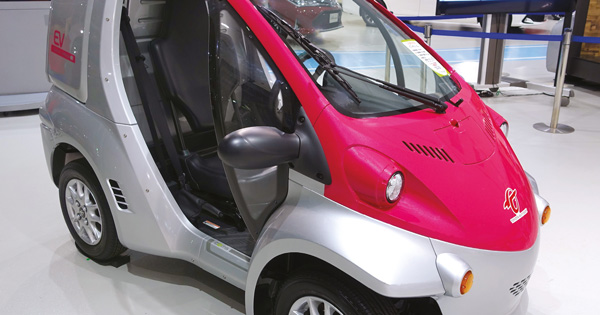AT THE WHEEL

BMW redesigns its iconic logo
March 5, 2020
GENERATION NEXT
March 5, 2020TOYOTA COMS EV
TAKING ON THE TUK-TUKS
Mat Ranasinghe travels to Tokyo to find a solution to one of the problems associated with urban living

MODEL
Having witnessed plenty of EV concepts and pre-production models over the years, it’s nice to see EVs turning into a mass marketable reality. Coms is about as comfortable as a tuk-tuk, and able to carry one person and a limited amount of cargo. Flexible add-on cabins, trays and cargo boxes may come in the future so the possibilities can stretch as far as the imagination permits.
A city that’s densely built-up, and narrow roads swarming with pedestrian traffic and properties constructed to the maximum permitted space with only a handful of parking slots available… We were in Tokyo but could be talking about any densely populated global city. Add to this equation the unruly tuk-tuk drivers with self-proclaimed traffic guidance skills and you’re confronted by gridlock!
The worst we’ve seen has been in cities such as Jakarta, Sukhumvit in Bangkok and certain parts of India that we would rather forget.
While Colombo’s traffic doesn’t fall into that extreme category, we do have a problem managing the volume of vehicles – especially at peak times. Many residents of the commercial capital who own cars choose the quicker option through this gridlock by using tuk-tuks. But as we know only too well, the humble ‘trishaw’ can often turn into one’s worst nightmare!
However, motorists shouldn’t lose hope because the solution could be around the corner in the form of a single occupant battery-powered compact EV city runabout.
Research has shown that most often in the busiest cities, five seater vehicles wastefully carry only one person – either a corporate executive to an office or homemaker to the shops. Several car manufacturers are working on solutions to this, and Toyota’s answers are the Coms and i-ROAD.
Renault’s version is known as Twizy and will be reviewed in the future.
Nissan has its own take on the urban EV with working prototypes that are currently known only as the ‘New Mobility Concept.’ This version has proper solid doors and a glass roof above the driver. The cohesive design is modern, almost robotlike, and forms a protective shell around the driver.
Meanwhile, Indian manufacturer Bajaj is developing a four seater EV version of its current petrol powered Qute (pronounced ‘cute’) quadricycle.
Back to the task at hand: let’s jump in and drive on!
On the road, the Coms feels rather agricultural – meaning that it feels a little rough around the edges or unrefined. To be fair, it’s not meant to be a luxury cruiser although we’re confident that luxury EV urban runabouts will make an entrance soon enough.
The shock absorber setup is rather stiff with little suspension over rough surfaces and the hard seat doesn’t help. Being made for Tokyo, it’s probably not necessary to have a soft springy suspension. However, let’s suggest that the model for Sri Lanka be sprung extra soft to handle our potholes and bad patches.
As for equipment and controls, they’re rather basic with a single indicator stalk, basic non-air bag steering wheel and a hardly legible speedometer, which we were struggling to read on the move. We drove the Coms in heavy rain and had to use the zip-up side covers to keep ourselves dry.
And as you accelerate, there’s that usual electric motor hum. It’s a sound you’d be used to if you own or have used an electric personal mobility device (PMD). These PMDs are being banned in several cities over safety concerns with the most recent to do so being Singapore. Let’s hope these EVs don’t end up the same way thanks to irresponsible drivers.
You may have heard of bike share schemes where one can pay and rent a cycle for a limited duration by using an app. In Sri Lanka, we have the manual version of such a bicycle-sharing system at Independence Square where you can hire a bike for Rs. 100 or so for an hour but you have to pay cash at a counter rather than on an app.
In Tokyo, a company called Ha:mo rents Coms and i-ROADs to members of the public (who possess a valid driver’s licence, of course) for whatever period necessary. This would be an amazing solution for Colombo – as long as we can stop people stealing parts for their personal EVs – so that finally, we can say goodbye to the dreaded three-wheelers.







